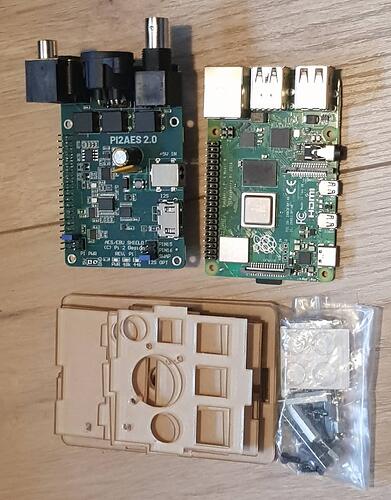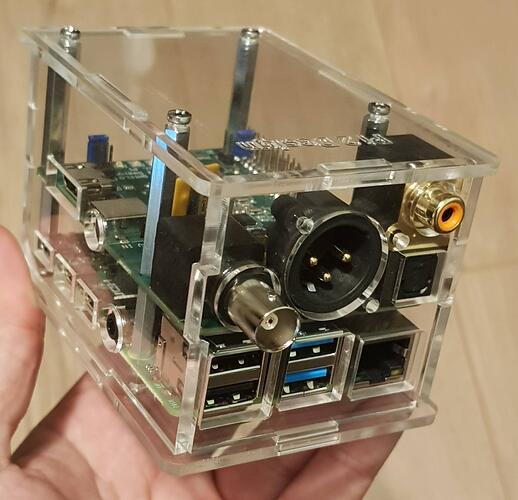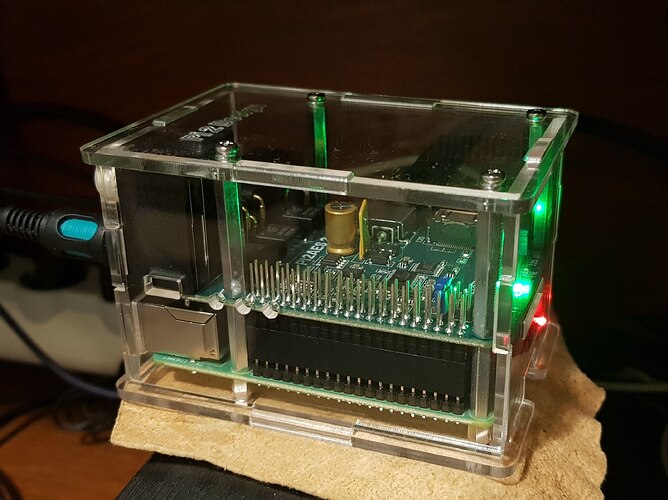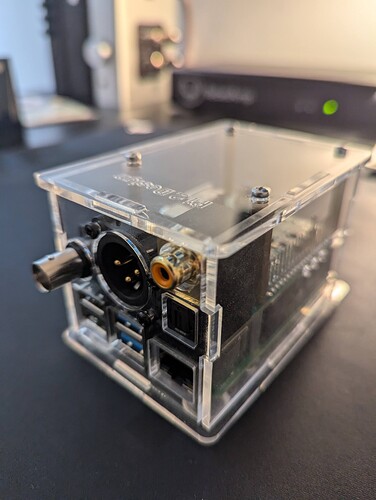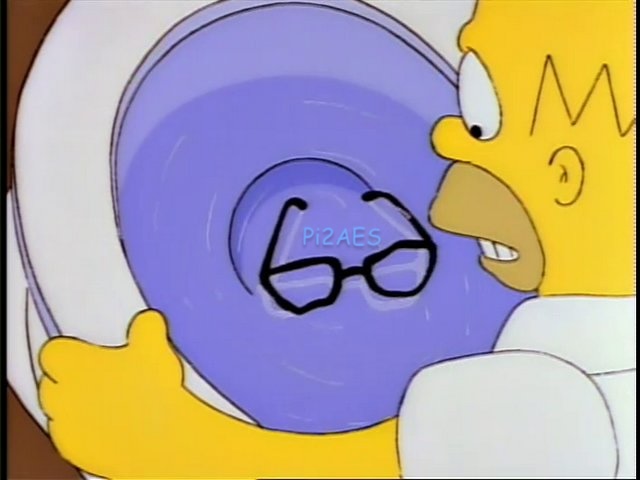Raspberry Pi 4 is powered by a Raspberry Pi PSU, and the hat is powered by a Jcat Initio 3. I can’t tell you anything so far because I have no decent optical cable. A QED Reference Optical Quartz (real glass 100 Euro cable) will arrive in 3 days. Audio files will be stored on a 1TB SD card (currently a 64GB SD card for tests), the idea being to avoid any USB connection, AND avoid any network storage that will be just burning money if you care about the quality.
This will be judged against a Pro-Ject Stream Box S2 Ultra hosting files on an external SSD and a 5$ USB cable. On paper should outperform the Streambox but we will see. If it outperforms it by a reasonable margin I plan to upgrade to a CrystalDigit Standard Diamond BNC/RCA 75 Ohm cable, but I am not investing that much if it is really close to the StreamBox.
Looks great, will be curious about your thoughts when you get cabling in ![]()
Ok, so I got the fiber optic, and yes there is there is big difference between cheap fiber optic and quality fiber optic. No it is not just an opinion it is proof for that. Cheap fiber optic did NOT manage to transport 64 DOP, while the real glass one did it very well.
On the topic on hand, was tit an improvement over Pro-Ject Stream Box S2 Ultra? Yes. Was it obvious? Yes. Was it night and day? No. the background was slightly darker, the texture slightly more apparent, but where the difference went from “Is it just my impression?!?” to “It’s definitely better” is when I noticed for the first time very quiet but distinct sound in tracks I know very well, and the sound was more fluid somehow. I know it sounds BS but that’s how I perceived it.
Is this going to sound just as well with a cheaper PSU? I have no idea. It will definitely not be just as good with a 50$ ifi one, but I can’t tell you how low you can go and not see a big drop in quality.
Another thing I noticed, and this my be specific to just Qtest, if you play DSD via USB and pause the music, you are in for some nasty hi frequency sound that will go away when music resumes. With fiber optic this problem is completely gone.
If you got any other DAC, and you are using Pro-Ject Stream Box S2 Ultra, I do not think it is worth the 1700 Euro to get everything, but If you have a dac that runs on a 1000 Euro PSU (yes even a 500Euro Neo iDSD sounds better with a 1000 Euro PSU then a 1500 Euro stock Qtest so it is worth the money), and has an output to spare, or upgraded the dac and have a 5v quality PSU, maybe got a Raspberry Pi around the house, then yes it is worth the upgrade.
If you are just starting out, then Initio 3 + Qtest / Neo iDSD + P2AES 2.0 is a really good thing to aim for and for many will be good enough for their entire life, plus the HAT is cheap enough to upgrade every 2 generations to get a better clock and lower jitter.
PS.
on the store page for QED Reference Optical Quartz cable someone said it needs 100h of burn in. I do not believe in Glass burn in so will not test it. If at any point music will miraculously sound better without me changing anything (all my current gear is passed burn in period), I will report back but I would not hold my breath on that one.
Edit: HAT is on for a week so clocks are stable, and cable has around 100H of use. What I heard last night was was much more bite and aggression on upper mids and highs and I had turn the volume down. All the details were there but the sound was a little more aggressive and lauder. The upside, is I heard sounds I never knew were in the song, like very quiet footsteps or instrument handling before actually play them. I can’t say is glass burn in or just clocks on the hat being more stable, but this is the change I heard., so take your pick. I just want to mention that once the volume adjusted there was not harshness, glare or anything that would become annoying.
Hello,
Thanks for your detail info on your new setup. You mentioned about using an SSD directly connected to the RPI, what software are you using ? is it pirecore or something else? I am planning to get the V2.0 as well as I prefer to use i2S with my pontus ii vs wiim mini/pro.
Thanks in advance
I am using Volumio, and I do not use SSD on PI2AES, I used it on my Pro-Ject streamer. On Pi2AES I load my files on the SD card from the raspberry pi. I keep hearing that USB is bad for sound quality, so I aim to not have any USB in the chain. However since it is free to try, I will plug my SSD in to Pi2AES and see if I can hear a difference between USB storage and SD card.
Got it thanks!
Reporting back on USB vs SD
I just checked and in this case USB degrades indeed the sound quality. It is not a huge jump but when you a-b you notice upper mid is clearer and better defined, so for better results you want to get a larger card (I am looking at a 1TB) and after you write Volumio OS, you will be able to transfer files on it via network on //volumio.local or //192.168…. streamer ip adress. Good luck.
I just want to make aware that with pi2aes sends I2S as follows R3+hat - Gustard standard, R4+HAT - PS Audio standard. Make sure you check what standard your DAC uses and buy the appropriate Raspberry PI.
Thanks for your help. Looks like Pontus is based on PS audio std as well. Let the adventure begin ![]()
My initial impression with the PI2AES 2.0 out the box was that it was…off. My Zen Stream chain being fine tuned like when an optometrist tests your vision for prescription lenses, this steamer was immediately uncomfortable, like wearing someone else’s glasses.
I should also point out that the 2.0 retails for $300 before adding the Pi4, twice that of its predecessor.
(Note: The Zen was USB-out, and the PI2AES 2.0 used coax spdif out, which measured best in its reviews; the Zen was being fed Airplay from Plexamp on my Macbook and the PI2AES was fed Plexamp endpoint directly on Ropieee, bit perfect)
Shortly after tiring of its stock performance (on LAN, fwiw), I decided I needed to remove the power jumper and try powering the Pi2AES hat and Pi separately, which actually helped a lot. In my case, now I was running both streamers off a Topping P50, and when taking notes the initial harshness was lessened in this config, and the differences were narrowed with a clear distinction that the Pi2 was more vocal forward - be it sharper or clearer, it was more in my face. I read other reviews online comparing the 1.0 unit to the Lumin U1 Mini and Holo Red, and those users had similar results pointing out the Pi2’s unmellow highs.
I tried removing my iFi LAN iSilencer (which was on my Zen Stream) and putting it on the Pi2’s LAN port, after which the Zen started to feel muddy, softer or diffused by comparison to the crisp treble, but it was still overall better and with more texture on those same vocals, and it allowed me to push the volume higher, so by comparison I’d say the Pi2 was ‘less dynamic’ feeling.
Giving up on this shootout I wondered what it would be like if I powered the Zen Stream off my A32 LPS that I just had wastefully powering my router and switch, and surprisingly it was a positive move that also coincidentally brought the vocals forward, which made for an even closer comparison. The next day when I sat down to compare the two, without the vocal depth to fixate on, the Pi2AES 2.0 just felt flat and boring, very two dimensional and switching to it felt like an immediate, subtle downgrade in quality. It was like going from FLAC to MP3.
I also tried doing another test where I enabled WiFi and kept it powered by switch-mode power supplies only, just to compare the most optimized Zen config to the least optimal Pi, and oh god, this sucked. It really sucks. Harsh, flat, shrill, and compressed. Unlistenable enough that I had no desire to do much testing after a few songs.
So that’s my experience with the PI2AES 2.0. Ultimately, very disappointed after all the golden reviews out there. Stock power on WiFi, this thing is awful. I wanted to say maybe this is a good example of measurements not meaning much, but at the same time going with less noisy (and thus, measurably better) configs on this is a must: be it the 5v mod on the 1.0 or just powering the hat separately on the 2.0 with an LPS, and definitely never using the Raspberry Pi WiFi. In a more optimal state, it’s fine, just not a keeper for me.
